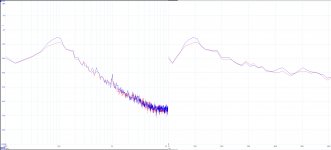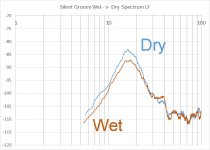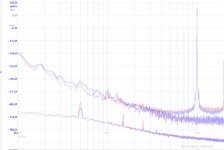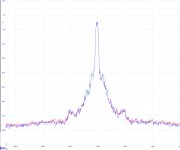Thx Bill interesting stuff.Couldn't find the ones I was looking for yet, but here is a starter for 10 on the effect of a silicone damping trough on an SME 3009 S111 with a MM cart on it......so 10Hz and below the resonance is damped, but 20-50Hz looks worse. I have not sat an pondered this so just throwing it out there. I am sure I can get the raw files for anyone who has an idea how to analyse.
Yup below resF headshell moves in phase with pointy end. Above resF it's antiphase, so sub lf audio band gets attenuated a bit until at some f it tapers to stationary. As Q decreases through damping, the transition can push into lf audioband if theres any content there. As well as attenuating the resonant peak in the spectrum, of course.
On seperate point, I think the silent groove spectrum method works because there's random variation in skate force, a stimulus for the headshell to move.
LD
No it does not. Remember the wet / dry tests ?
With my linear tracker zero difference, probably because of having no skate force.
Hans
I’ll try to find those spectra of a silent track.
With my linear tracker zero difference, probably because of having no skate force.
Hans
I’ll try to find those spectra of a silent track.
Last edited:
Hi Bill,
Here are my recordings.
The first image with 4 recordings goes from 10Hz to 10Khz,
Text in the images explains itself.
Second image is starting at 1Hz, with resp. a log and a linear frequency scale.
Recordings are without rumble filter but with Riaa correction.
Hans
Here are my recordings.
The first image with 4 recordings goes from 10Hz to 10Khz,
Text in the images explains itself.
Second image is starting at 1Hz, with resp. a log and a linear frequency scale.
Recordings are without rumble filter but with Riaa correction.
Hans
Attachments
Last edited:
Each time I do this I remind myself it isn't a dream....
So this morning I made a recording of silent groove, wet and dry again. Identical section of record (actually a gap between tracks) made without removing record from platter. Recordings made within 1 minute of each other, identical recording settings. Dry recorded first.
This is asnapshot of the whole spectrum, no RIAA. One channel (left).
One can see the effects (inc at LF) can be profound.
LD
So this morning I made a recording of silent groove, wet and dry again. Identical section of record (actually a gap between tracks) made without removing record from platter. Recordings made within 1 minute of each other, identical recording settings. Dry recorded first.
This is asnapshot of the whole spectrum, no RIAA. One channel (left).
One can see the effects (inc at LF) can be profound.
LD
Attachments
Here's a more detailed look at the LF part of the spectrum and the LF resonant system, wet-v-dry, same conditions as above. Recordings made this morning. Left channel only.
It's not that wet playback changes Q of the resonant system, it just appears to reduce stimulus for headshell to move. DEFINITELY Not advocating wet playback, just illustrating one aspect of what goes on with headshell stability.
I believe this effect is prob due to reduced random variation in skate force in turn due to reduced tick-pop and general unwanted yanking on the pointy end during wet playback. The mix used was 25% IPA/water. The arm is a fairly nondescript RB250, conventional.
LD
It's not that wet playback changes Q of the resonant system, it just appears to reduce stimulus for headshell to move. DEFINITELY Not advocating wet playback, just illustrating one aspect of what goes on with headshell stability.
I believe this effect is prob due to reduced random variation in skate force in turn due to reduced tick-pop and general unwanted yanking on the pointy end during wet playback. The mix used was 25% IPA/water. The arm is a fairly nondescript RB250, conventional.
LD
Attachments
Hans, just about every condition had changed. Arm, cart, RIAA in/out, no phono preamp, the physical record etc etc.
One big variable IIRC is simple difference between records - some do and some don't and all points in between plus the spectral character of surface noise events varies.
LD
One big variable IIRC is simple difference between records - some do and some don't and all points in between plus the spectral character of surface noise events varies.
LD
LD,
Conclusion can only be that there is a huge spread in spectra between various combinations of arm/cart/record/etc.
The only thing that seems to be meaningful is the frequency of the resonance peak.
Hans
Conclusion can only be that there is a huge spread in spectra between various combinations of arm/cart/record/etc.
The only thing that seems to be meaningful is the frequency of the resonance peak.
Hans
Hans, well we already know there's 'huge' variation in surface noise between records and rigs if that's what you mean... in terms of LF headshell stabilty, point is this evidently varies too. And appears to correlate.
What does it matter whether Resf is 8Hz or 16Hz? Whereas settle time in response to headshell disturbance does matter, and can be improved either by avoiding stumuli or by decreasing settle time of the resonance.
It's far easier to see this in the time domain, I think.
LD
What does it matter whether Resf is 8Hz or 16Hz? Whereas settle time in response to headshell disturbance does matter, and can be improved either by avoiding stumuli or by decreasing settle time of the resonance.
It's far easier to see this in the time domain, I think.
LD
The level of the resonance on an undamped arm also seems to vary by about 30dB across tracks on an album. Which makes sense as the stimulus is variable.
Bill, yes and programme material can be a big stimulus in real use. Just trying to explain in part why a silent groove still works for this method and shows a response.
LD
LD
That's then another big difference between a linear and a non linear tracker.
Images are always the same with my arm when no other content at LF but noise, but even when there is 1Khz test tone playing.
See image below with three plots projected on top of each other.
The lower one is the noise with the arm in the air, then resp. playing a silent track and playing a track with a 1Khz test tone.
Up to 300Hz the curves are the same for just noise and with a 1Khz test tone.
But whether this can be seen as an advantage or not, no idea, but obviously skating forces on a non linear tracker are causing great differences.
And as LD mentioned, settling time is most important because of the IM distortion it produces.
See second image of a 1Khz test tone enlarged on a linear frequency scale. Clearly visible are the +/-10Hz at -42dB and +/-20Hz IM products at -60dB.
Hans
.
Images are always the same with my arm when no other content at LF but noise, but even when there is 1Khz test tone playing.
See image below with three plots projected on top of each other.
The lower one is the noise with the arm in the air, then resp. playing a silent track and playing a track with a 1Khz test tone.
Up to 300Hz the curves are the same for just noise and with a 1Khz test tone.
But whether this can be seen as an advantage or not, no idea, but obviously skating forces on a non linear tracker are causing great differences.
And as LD mentioned, settling time is most important because of the IM distortion it produces.
See second image of a 1Khz test tone enlarged on a linear frequency scale. Clearly visible are the +/-10Hz at -42dB and +/-20Hz IM products at -60dB.
Hans
.
Attachments
Yes, it's indeed a very tidy rig, Hans.
Any radio bods out there have the tables for what -40dB 1st sideband amplitude corresponds to as FM modulation index?
LD
Any radio bods out there have the tables for what -40dB 1st sideband amplitude corresponds to as FM modulation index?
LD
Hans,Clearly visible are the +/-10Hz at -42dB and +/-20Hz IM products at -60dB.
Hans
.
I think the +/-10Hz and +/-20Hz artifacts you are seeing are more likely FM from stylus scrubbing than simple IM from nonlinearities. I have modeled the stylus scrubbing behavior of a Linear Tracker in a mechanical linkage program for both vertical motion and horizontal motion.
Vertical Linkage Motion – Linear Tracker:
[23] Arm 3 - Linkage Cantilever View - YouTube
For vertical motion, the scrubbing motion and attendant FM occurs substantially at the resonance frequency, 10Hz. There is asymmetry in the scrubbing, which also results in some FM modulation at 20Hz.
Horizontal Linkage Motion - Linear Tracker:
[16] Arm 2 - Linkage Stylus View - YouTube
For horizontal motion, the scrubbing motion and attendant FM in a Linear Tracker occurs at twice the resonant frequency, 20Hz instead of 10Hz.
If you would be so kind, I see an opportunity here for an experiment. Run the test again twice. For the first run, sum the 2 channels to mono in phase, to focus on distortion products from horizontal motion. For the second run, sum the 2 channels to mono out of phase, to focus on distortion products from vertical motion. It would be interesting to see if the “IM” distribution is different when examined as a horizontal/vertical comparison rather than just L & R output.
Ray K
Last edited:
Off topic for a split second if I may; Hans, any relation to the Porsche race car driver from the 70's?
Last edited:
- Home
- Source & Line
- Analogue Source
- Tonearm/Cartridge/Compliance: Compatability






